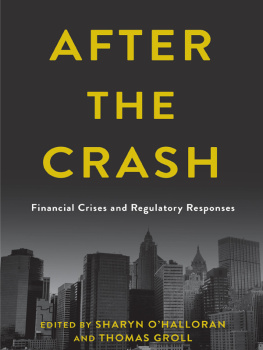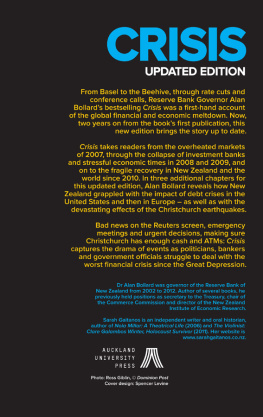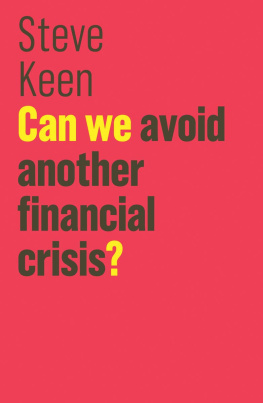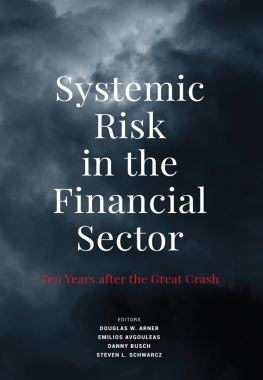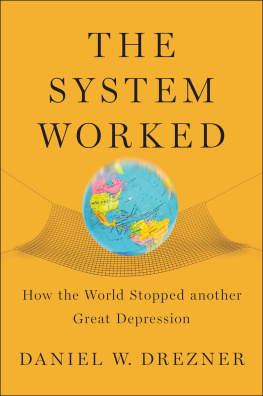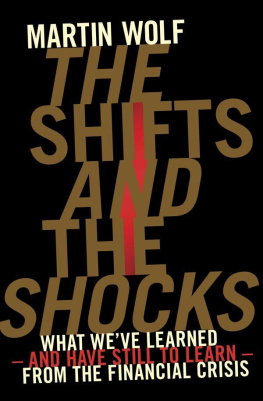Table of Contents
AFTER THE CRASH
AFTER THE CRASH
Financial Crises and
Regulatory Responses
EDITED BY
SHARYN OHALLORAN
AND THOMAS GROLL
Columbia University Press
New York
Columbia University Press
Publishers Since 1893
New York Chichester, West Sussex
cup.columbia.edu
Copyright 2019 Columbia University Press
All rights reserved
E-ISBN 978-0-231-54999-8
Cataloging-in-Publication Data available from the Library of Congress
ISBN 978-0-231-19284-2 (cloth)
ISBN 978-0-231-54999-8 (electronic)
LCCN 2019000324
A Columbia University Press E-book.
CUP would be pleased to hear about your reading experience with this e-book at .
Cover design: Noah Arlow
To my parents,
Sally and James J. OHalloran
CONTENTS
DAVID MADIGAN
SHARYN OHALLORAN AND THOMAS GROLL
SHARYN OHALLORAN, THOMAS GROLL, AND GERALDINE McALLISTER
GLENN HUBBARD
THOMAS GROLL, SHARYN OHALLORAN, AND GERALDINE McALLISTER
ANTOINE PARENT
PIERRE-CHARLES PRADIER
NOLAN MCCARTY
JACOB J. LEW
VINCENT BOUVATIER, GUNTHER CAPELLE-BLANCARD, AND ANNE-LAURE DELATTE
JEFFREY N. GORDON
JOSEPH E. STIGLITZ
EMANUEL DERMAN
ELI NOAM
SHARYN OHALLORAN AND NIKOLAI NOWACZYK
MARK D. FLOOD
PAUL TUCKER
STEPHEN M. CUTLER
BARNEY FRANK
JOHN C. COFFEE JR.
JOHN C. COFFEE JR., STEPHEN M. CUTLER, BARNEY FRANK, AND KATHRYN JUDGE
WILLIAM T. WINTERS INTERVIEWED BY AILSA RELL
VIKTORIA BAKLANOVA AND JOSEPH TANEGA
MARK J. ROE AND MICHAEL TRGE
AGOSTINO CAPPONI
SHARYN OHALLORAN AND THOMAS GROLL
DAVID MADIGAN
T he financial contract may be mankinds greatest invention, but it undoubtedly causes all kinds of trouble. The crisis of 20072008 had profound consequences across the globe, and so, a decade after the crisis, it is appropriate to pause and take stock of its implications.
The immediate causes of the crisis may be relatively clear: widespread failures in financial regulation, including the Federal Reserves failure to stem the tide of toxic mortgages; dramatic breakdowns in corporate governance; and an explosive mix of excessive borrowing and risk by households and by Wall Street. Though the causes are simple enough to state, the result in human misery was calamitous.
Over the past 250 years, there have been many similarly calamitous economic and financial crises in the United States and globally: the panic of 1792; the 1825 Latin American crisis; the global crisis of 1857, triggered by railroad stocks and involving runs on major banks; and yet another banking crisis in 1907 involving a run on banks. In 1929, another crisis occurred: commonly referred to as The Big One, today it might simply be considered A Big One. In short, five particular crises wreaked havoc on the kind of scale seen in 20072008. Although no one wants to see a repeat of this crisis, we are still unsure how to prevent such crises in the future. The extraordinary convergence of grave events a decade ago is not the first such incident.
A decade later, therefore, I invite everyone to consider how, through regulation and other means, we can prevent another financial crisis.
SHARYN OHALLORAN AND THOMAS GROLL
I n March 2008, the world was transfixed as it watched the unraveling of Bear Stearns, one of the worlds most prestigious investment banks. What ensued was the largest financial and economic crisis since the 1930s Great Depression. The sudden and rapid decline of the financial market that led to a significant contraction in economic activity, coupled with historic levels of unemployment and a double-digit drop in housing prices, placed millions of hard-working Americans and others around the world in an impossible squeeze. Many lost jobs just as the underlying value of their homes fell by as much as 40 percent. The combined impact of lost jobs and declining home values meant that families could not afford to sell their homes. In many cases, the only choice was to take a large loss or enter bankruptcy. For most, the latter was the only option.
In making these statements, we do not absolve individuals of fiduciary responsibility any more than we absolve regulators and bankers of the obligation to fulfill their responsibilities. But it is hard not to see the rise of the populist movement, Trumpism and antiglobalism, as a backlash to the failure to help the average citizen weather the financial turmoil.
The essays contained in this compilation look back to look forward. We examine if the actions and reforms put in place in the aftermath of the financial crisis have made the financial system stronger and better positioned to withstand the next crisis when, not if, it comes.
In short, have we learned the lessons and implemented the necessary policies to mitigate future damaging effects? One common theme that runs through the chapters is the notion of risk and its relation to liquidity in the financial system. Risk takes many forms: market, financial, strategic, and managerial. But in a number of different ways, each chapter addresses whether actions taken during and after the crisis have provided policymakers and market participants with better tools to identify, evaluate, and mitigate these risks when they arise.
Clearly, these were and are risky times for banks, creditors, regulators, and policymakers around the world. The chapter authors are well-known, leading experts in government, business, and academia on various aspects of finance and financial regulation. We hope the chapters shed light on how to think about the risky business that was the financial crisis, how ad hoc policy responses came about often in the depths of uncertainty and surrounded by controversy about effectiveness and fairness, and how we can do better in the future to manage risk and prevent crises that affect so many.
The project was made possible not only by its contributors but also by the support of many who made the conference a success and this volume a reality. Both the conference and the edited volume are a combined Columbia University effort, facilitated by the administrative and financial support of the Columbia Business School (CBS), the Columbia Law School, the School of International and Public Affairs (SIPA) with its Center of Global Economic Governance (CGEG), the Data Science Institute, the Institute for Social and Economic Research and Policy (ISERP), the Graduate School of Arts and Sciences, and the Richard Paul Richman Center.
We would like to thank Maria Cecilia Barcellos-Raible and her team from SIPAs Picker Center, Joe Chartier and his team, JoAnn Crawford, Stephen Francis, Theresa Murphy and her team from CGEG, and Kathleen Rithisorn and her team from the Richard Paul Richman Center for their support. Stephen Wesley from Columbia University Press supported this project from the beginning and, together with Christian Winting, helped us greatly in sharing the expertise of our contributors on this important issue. Numerous students have helped us to organize the conference and review the contributions to this volume: Anthony Cruz, Daniel Eem, Jocelyn Fahlen, Kate Han, Wesley Hu, Antigone Ntagkounakis, and Mateo Tate-Contreras. We would like to thank Geraldine McAllister for her invaluable assistance.

